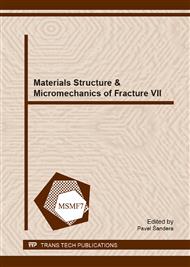p.121
p.125
p.129
p.133
p.137
p.141
p.145
p.149
p.153
Micromechanical Modelling of Advanced Ceramics with Statistically Representative Synthetic Microstructures
Abstract:
Advanced ceramics are a class of material used in extreme conditions, such as high speed turning of aerospace alloys and rock drilling. Their high hardness makes them suitable for these uses, however their lower toughness means that failure due to fracture and chipping is a problem. They are composed of micron-sized particles of a primary hard phase together with either a ceramic or metallic matrix material. A combined experimental-numerical method was used to investigate the role of microstructure on the fracture of advanced ceramics. Two dimensional, statistically representative microstructures of the advanced ceramics are created using Voronoi tessellation. The synthetic microstructures are compared to real microstructures in terms of particle size distribution and particle aspect ratio. Simulation results indicate that the computed elastic parameters are within the Hashin-Shtrikman bounds and agree closely with analytical predictions made with the Eshelby-Mori-Tanaka method. It is found that the local stress and strain distribution within the model is significantly affected by the underlying microstructure, which in turn affects fracture properties. Hence, tailoring the microstructure can optimise the bulk strength parameters of the material.
Info:
Periodical:
Pages:
137-140
Citation:
Online since:
November 2013
Price:
Сopyright:
© 2014 Trans Tech Publications Ltd. All Rights Reserved
Share:
Citation:


